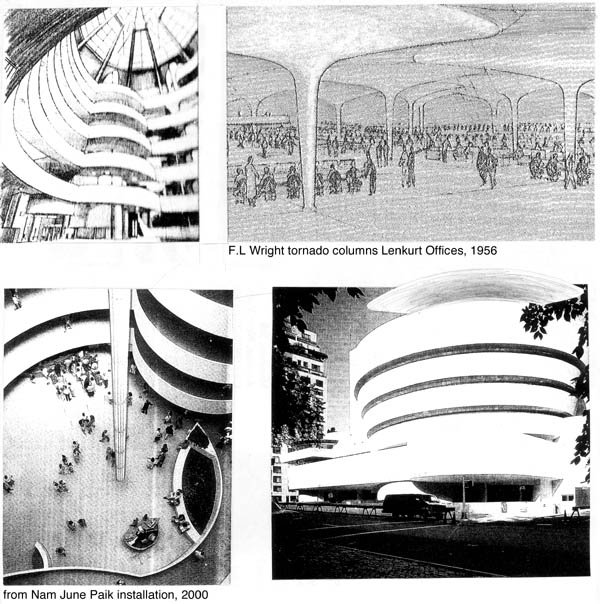Guggenheim Visit: El Greco to Picasso
There are few shows that can detract from the architecture of the Guggenheim and "Spanish Painting from El Greco to Picasso" is not one. It could have been, if only the curators didn’t try so hard to ramp it up. It was exhausting. There was too much stuff to look at. Every niche was filled when all that was needed was half the art. Every other stall should have been set aside for seating and to peruse descriptive narratives.
Billed as one of the most comprehensive exhibitions of Spanish art ever mounted in New York, the length of the ramp obviously dictated the size of the show and it was too long. They laid it on thick and yet were spread thin. The connections and affinities drawn were faint and the 15 thematic sections were not that important me. I would have preferred a chronological order instead of the groupings. If they told me El Greco was Venetian and Picasso was French, it really wouldn’t have mattered much.
Everyone knows that artists copy each other and whatever came before them. The affinities in Juan Gris are arguably more African than Cotan. And furthermore, art allows free associations. That is why I usually skip the audio guide the first time around.
How is it possible to start with El Greco at the juncture of Late Mannerism and Baroque and not talk about the enormous influence of Caravaggio who, in a single painting launched both the Baroque and Bodegas (still life for it’s own sake) with the Basket of fruit 1596? They didn’t explain the wide stylistic disparity between El Greco (1541-1614) and Zubaran (1598-1664) or the tremendous secular impact of Low Country art. To suggest that these were mere coincidences makes no sense whatsoever but it went over big with the Spanish crowd.The compilation of artists was impressive but I was drawn mostly to Zurbaran, Velazquez. Murillo and Cotan who represent a Spanish school that I believe in essence is a blend of Caravaggism and Carracci academism that came by way of seventeen century Neopolitian painters such as Giovanni Battista Caracciolo, Artemisia Gentileschi, Massimo Stanzione and others. Jose de Ribera and Juan Bautista del Maino were a couple of the first Spanish masters to adopt Caravaggism. Ribera studied in Rome lived in Naples and Maino also studied with El Greco in Toledo. Additionally Velazquez was in Naples in 1630. All of this occurred while Naples was under Spanish Hapsburg rule. So to those who say there is no connection, I say phooey.
I found it strange that they did not cross reference the Frick which is currently showing a duplicate of the Mary and Christ by Zubaran, on loan from the Cleveland Museum. I saw them both within days and thought, am I out of my mind? How many replicas did he paint? But always expect strange things from the Grabbenheim, especially viruses. Sometimes I see the building as a constrictor poised to squeeze every penny from hapless victims. The sign in the gift shop said 50% OFF SELECTED ITEMS but what they really meant was 50% off a box of greeting cards from the show and it was still no bargain.
A word about the Architecture:It’s always fun to visit the works of a man who proclaimed himself on national television to be “the greatest architect the world has ever known". There are some nice things and there are some bad things about the place. The Guggenheim intrigues me for the unique views no other museum can afford and also for its abundant Vesicas. Seeing where you’ve been and where you’re going simultaneously, is worth any pejorative about the inclined plane. The ramp is both great for wheels and for viewing paintings from extreme distances and oblique perspectives, and best of all, you can’t get lost.
The show went up the ramp as usual and I saw it in reverse. Starting from the top, I set out on a leisurely stroll downhill looking at art, architecture and people. If Frank Lloyd Wright were here today jostling with all the tourists, he would join me in this reverse experience. A walk across the Park to Polshek’s Planetarium ramp would clear up any doubts he may have.
Things were different in 1959, museums were not as congested and commercial it is clear that the ramp was designed to function as a casual two-way promenade; up along the exterior and down along the interior. Furthermore, the slow undersized elevator could not be expected to be more than a convenience.The large elevators in the new annex can express visitors to the top but no one knows about them. By the time one enters the museum the exterior has left no doubt where to turn, people are drawn toward the vortex. Somewhere in the center there exists an unseen column of swirling energy that accounts for the mighty spiral. Of course the FLW purists regard it as sacrilege to suggest that this force could have been made manifest.
But I believe the bulge into the central space could be imagined as breaking free to assume the role of a free-standing elevator shaft in the form of a tornado-shaped column from his 1956 Lenkurt Electric Company project. It could suck people up to the top in cantilevered high-speed transparent elevators as soon as they enter. And why not? It’s no idea for a hack but, for the world’s greatest architect, it should be a snap.
It would’ve been much better to get a look at the worlds’ greatest park from a viewing platform at the top of the column before descending the ramp. Then one would have experienced the centripetal ramp as the result of the centrifugal pull to the vortex. It is the stuff of tornados. Oz anyone?

